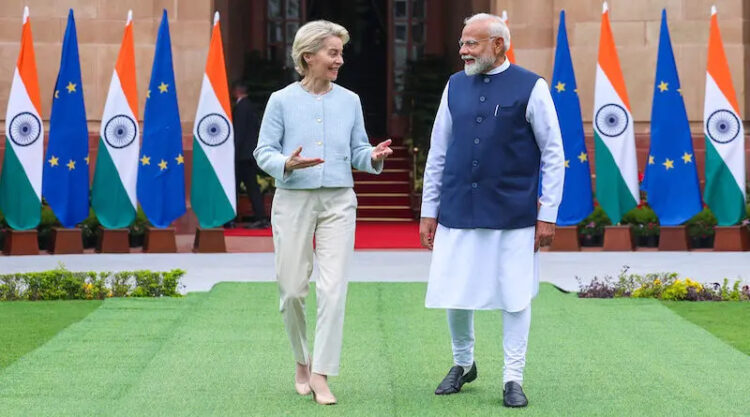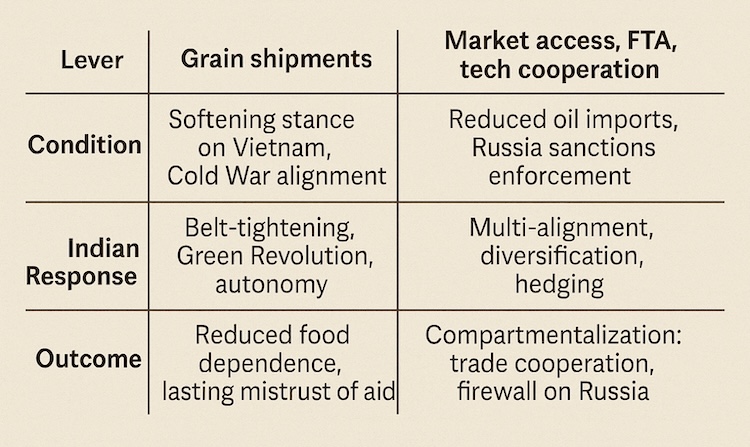Brussels Has Yet to Learn Lessons
This article first appeared on https://rjaura.substack.com
By Ramesh Jaura
BERLIN | 22 October 2025 (IDN) —Since the 1960s, India has prioritised strategic autonomy in its foreign policy, consistently avoiding alliances that could compromise its sovereignty. Western partners often overestimate their influence, overlooking India’s strong commitment to independence. For India, autonomy is not a tactic but a core principle.
In September 2025, European Commission President Ursula von der Leyen unveiled an ambitious India Strategic Roadmap with the world’s largest free trade agreement, a startup corridor, deeper Horizon Europe ties, and broad security and defence cooperation.
However, the agreement included caveats. The EU warned that India’s continued purchases of discounted Russian oil and joint military exercises with Moscow would impede closer ties.
Indian leaders anticipated this response and maintained their position. The legacy of the 1960s remains relevant, when the United States used the PL-480 “Food for Peace” program to influence India during the Cold War.
The core challenge remains: India consistently defends its autonomy, while Western partners often seek alignment as a condition for partnership.
PL-480: Food as Foreign Policy
The 1954 Agricultural Trade Development and Assistance Act, known as PL-480, was designed to dispose of surplus U.S. grain and build goodwill. For India, this aid was essential.
By the late 1950s, India faced recurring droughts, rapid population growth, and stagnant farm output. U.S. wheat imports through PL-480 soared, reaching nearly 10 million tonnes annually by 1965.
Though touted as humanitarian, PL-480 quickly became a foreign policy tool.
- Under President Lyndon Johnson, the U.S. enforced a “short-tether” policy, authorising aid in small, conditional tranches.
- Continued aid depended on India’s support for U.S.-Vietnam actions and alignment with Washington.
- When Prime Minister Lal Bahadur Shastri condemned the bombing of Hanoi in 1965, U.S. shipments slowed mid-drought.
The message was clear: food aid was contingent on political alignment.
India’s Response: Tightening Belts, Guarding Sovereignty
The PL-480 experience exposed the risks of dependence and reinforced India’s commitment to the non-aligned path envisioned by Nehru.
Non-alignment was an active assertion of independence. India engaged with major powers but consistently set its own terms.
Prime Minister Shastri made it plain: “We have to tighten our belts, but we will never sacrifice our freedom.”
This stance had significant consequences:
- The Green Revolution
The crisis led to a domestic agricultural revolution. By the 1970s, India no longer relied on foreign grain.
- Strategic Scepticism of Conditional Aid
PL-480 demonstrated that Western aid often includes conditions. This caution continues to influence India’s foreign policy today.
Brussels in 2025: A Familiar Tune, New Instruments
The EU’s 2025 Strategic Roadmap echoes the PL-480 era. While the focus is now on market access, technology, and supply chains rather than wheat, conditionality remains central.
Economic Leverage
The EU promises the “largest FTA in the world,” but links it to compliance with Russia sanctions, oil import curbs, and a crackdown on “shadow fleets.”
Security Incentives with Strings
Offers of defence cooperation and intelligence sharing depend on India aligning with Europe’s Russia policy and reducing its ties to Moscow.
Regulatory Conditionality
EU norms on data privacy, green standards, and due diligence act as informal pressure tools that shape India’s policies.
India no longer relies on foreign aid, yet the EU continues to use economic leverage to influence political decisions.
India’s Modern Doctrine: Multi-Alignment, Not Non-Alignment
India’s strategy still channels the instincts forged in the 1960s, now reinvented for a world of shifting power centers.
This approach represents multi-alignment rather than neutrality:
- Oil from Russia
- Weapons from France
- Chips from Taiwan
- Markets in the EU
- Capital from the U.S.
- Connectivity via the Gulf
India partners modularly:
- QUAD for Indo-Pacific security
- BRICS for financial coordination
- SCO for regional dialogue
This is a deliberate risk-management strategy. As the Green Revolution ended food dependency, multi-alignment now protects India from geopolitical challenges.
The EU’s Blind Spot
The EU’s sanctions-first approach defines post-Ukraine cohesion. Urging partners to follow supports a rules-based order.
However, this approach overlooks India’s realities:
- Energy Needs
- Discounted Russian oil is vital for India’s energy security and inflation control.
- Defense Interoperability
- Over 60% of India’s military hardware comes from Russia. Transitioning will take time.
- Global South Optics
- India’s approach resonates in the Global South, where many see sanctions as unilateral rather than universal.
The EU’s use of conditional tactics risks repeating the mistakes of the PL-480 era by overestimating its leverage and underestimating India’s commitment to autonomy.
PL-480 vs. EU Roadmap: A Comparative Lens
Three Lessons Europe Hasn’t Learned
- Autonomy Is Existential
India is willing to weather any storm to safeguard its independence.
- Compartmentalization Works
When interests converge—in mobility, technology, climate, or maritime security—progress follows. But when partners try to force connections where they do not fit, the effort backfires.
- Respect Builds Trust
India seeks partnerships built on mutual respect, not on condescension or demands for subordination. France’s defense engagement has been successful without requiring India’s ideological alignment.
Toward a Smarter EU Strategy
If Brussels seeks a meaningful strategic partnership, it should:
- De-link trade from sanctions politics
- Negotiate the FTA on economic merit.
- Pursue modular wins
- Talent mobility, green tech, maritime awareness, and startups offer quick progress.
- Embrace India’s multi-alignment
- Multi-alignment strengthens Europe’s China de-risking strategy.
- Engage in quiet diplomacy.
- Sensitive issues such as shadow fleets should be addressed discreetly, not through public pressure.
The Continuity of Autonomy
From the grain crises of the 1960s to today’s energy crunch, India has weathered wave after wave of Western economic pressure, emerging each time more resilient than before.
This pattern continues: India resists external pressure, adapts, and becomes increasingly self-reliant.
PL-480 unintentionally birthed the Green Revolution.
Today, EU conditionality could spark fresh breakthroughs in homegrown defence, clean energy, and financial innovation in India.
Europe must recognise that a genuine partnership can succeed only when India’s autonomy is respected and protected, without exception. Any attempt to pressure India will only strengthen its independence, the very quality others seek to influence.
About the author: Ramesh Jaura is a journalist with 60 years of experience as a freelancer, head of Inter Press Service, and founder-editor of IDN-InDepthNews. His work draws on field reporting and coverage of international conferences and events. [IDN-InDepthNews]
Original link: https://rjaura.substack.com/p/from-food-aid-to-free-trade-europe
Related link: https://www.eurasiareview.com/17102025-from-food-aid-to-free-trade-europe-courts-india-with-caveats-analysis/


